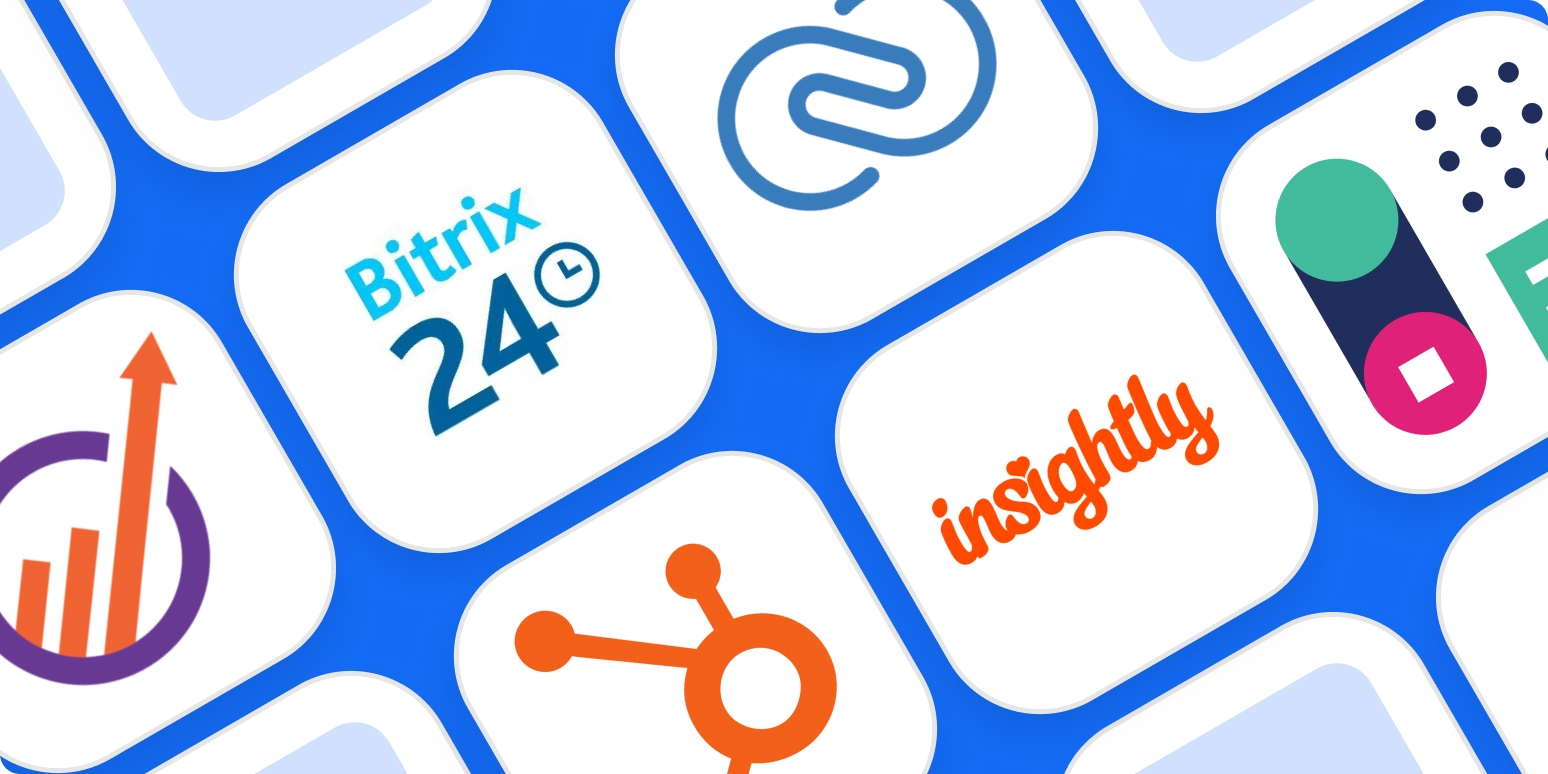If you landed here, you might be using Excel, Google Sheets, or the humble notebook to keep track of your sales, contacts, and even projects. If so, your life is about to become a lot easier. With customer relationship management (CRM) software, you’ll be more organized and productive and better able to serve your clients. And it won’t cost you anything.
Boost your team’s productivity
Dozens of companies offer free CRM plans in the hope that you’ll like using their product so much, you’ll eventually upgrade to a paid plan, or at the very least, recommend it to others.
We considered over two dozen free CRMs, and after extensive testing, we narrowed the final list down to eight that will serve a variety of businesses and use cases.
The best free CRM software
-
EngageBay for all-in-one business capability
-
Bitrix24 for businesses with a lot of users and contacts
-
Zoho CRM for scaling your business
-
HubSpot CRM for businesses wanting lots of integration options
-
Insightly for project management
-
Capsule for an easy-to-use free CRM
-
Vtiger for inexpensive upgrade options
-
Streak for managing contacts from a Gmail inbox
What makes a great free CRM?
The best CRM companies don’t try to reinvent the wheel—they just try to make it roll a little smoother. This means keeping things like the user experience fairly conventional so that anyone—even if they’ve only ever operated an email inbox—can get up to speed quickly. The CRMs featured here are all relatively easy to operate for first-time users and provide enough resources (support or self-help) to assist when and if issues arise.
And while the versions reviewed are all free, each company offers different levels of upgrade plans to accommodate businesses with evolving needs. These paid plans are affordable for most small and medium businesses, especially when the capabilities are expanded enough to take the place of additional standalone software such as marketing and support.
Below are the features we looked at when researching and evaluating free CRMs. While not every one of our picks checked off all five boxes, the ones that didn’t offered enough compelling features or highly specific use cases to make the final cut.
-
Contact and sales management. When creating contacts, you should have some flexibility in the type of information you can add. Features like custom fields let you collect what info is important for your business. Also, a free app should provide room for at least several hundred contacts to get you started. Tracking deals is a must-have feature for any CRM, and those that provide a visual (e.g., Kanban) pipeline with the ability to customize stages based on your sales process are ideal.
-
Ease of use. CRMs should make it relatively easy to perform repetitive actions (e.g., contact creation), input information, and provide a system with some customization options. We also looked for features that help automate actions such as performing tasks (emails, calls, etc.) as part of a sales process.
-
Unique feature(s). If a product included a unique (or atypical) feature not usually found in free plans, we highlighted that in the review.
-
Reporting and analytics. At the very least, you should have reporting to track total pipeline, deals by rep, and activities such as calls, emails, and meetings. Some of the apps we selected also had forecasting, leads by source, and average sales cycle duration.
-
Integration with other apps. We valued CRMs that provide integrations with third-party apps, whether natively or with Zapier, since a CRM is just one part of your business’s tech stack.
Best free all-in-one CRM software
EngageBay (Web, iOS, Android)

It’s getting harder each year to find a free CRM that provides sales, service, and marketing functions. Understandably so. That’s a lot to ask for a freemium app. EngageBay, a relatively new kid on the block, is one of the few gratis all-in-ones left. Not only that, the company makes upgrading to paid plans very affordable.
The app comes with 500 contacts, and each contact record shows a 360-degree view. Visible (when applicable) are activities, emails, deals, tasks, notes, workflows, chats, events, and other touchpoints that allow users to see how a contact has interacted with your company over time.
Create multiple—one of the few to allow this option—customizable pipelines for different sales processes or products. Sales sequences, which let you create, schedule, and track a series of automated, personalized emails for following up with contacts and leads, is another feature usually not found in a free plan. Sequences are also found under the marketing module, with the same setup process and functionality.
The marketing suite includes lead scoring, forms, pop-ups, email templates, landing pages, newsletters, and other tools to both capture and nurture contacts. EngageBay offers a nice selection of templates for these tools, or you can create your own from scratch. I created a newsletter pop-up for my personal website using one of the templates and launched it by adding some code to the HTML.
While creating automated workflows is only available in the two highest-tiered paid accounts, you can design and send emails and videos to your segmented lists. The social suite lets you add and monitor your Twitter, LinkedIn, Facebook, and Instagram accounts. I connected my Twitter account, and within a few seconds, my feed, mentions, and retweets popped up on the screen. From here, you can also schedule posts for channels.
For basic support management, the service suite provides ticket creation, automated assignment, and a dashboard for tracking ticket priority, first response time, and ticket count. With the live chat feature, you can create an additional support or sales channel and then track total chats, chat duration, and first response time in the dashboard. I tested the chat tool on my site, and while it’s fairly basic, for those new to chat and/or those running a small business, it should be adequate.
Stretch EngageBay’s functionality even more by connecting it to Zapier. For example, you can add new EngageBay contacts to your email marketing tool or add new customers from your eCommerce site to EngageBay.
EngageBay Price: Free for 15 users; all-in-one paid plans from $10.79/month/user
Best free CRM software with unlimited users and contacts
Bitrix24 (Web, Windows, Mac, iOS, Android)
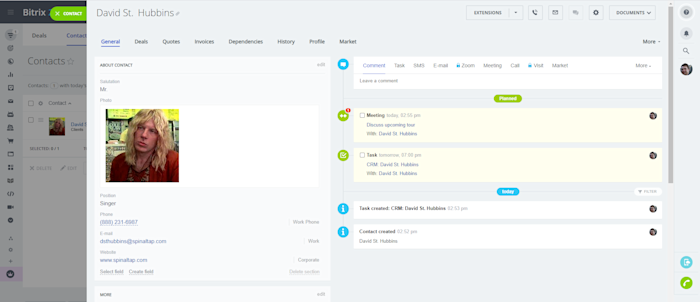
With most CRMs, especially free versions, you are limited to a certain number of users and contacts. Bitrix24 is the lone exception in our selection to offer unlimited for both (HubSpot offers unlimited users and 1 million contacts). This, combined with its other features, makes it stand out from the crowd. Aside from contact and deal management, the app also has team collaboration tools such as workgroups, chat, internal activity streams, and polls.
Bitrix24’s many features make it feel a bit overwhelming at first, but you can hide, delete, and change the order of the various menu items. Then, from inside each menu item (e.g., CRM), you can configure the order of items (e.g., deals, contacts, companies, analytics). If you ever want to see everything at a glance, click the Sitemap icon toward the bottom-left of the menu.
With unlimited users, you can invite your entire team to use Bitrix24, slotting them into the app departments you create. Once your employees accept the invite, they’ll be given access to their own customizable version of the app. However, you must upgrade to the paid versions to assign permissions to each user for viewing and making changes.
In a contact record, you can configure the menu to show only what’s important to your company, and you can add fields or rearrange them while you’re in a record just by dragging and dropping. For each record, you get all the details and functions (email, call, notes, etc.) at-a-glance with no need to click around a record just to see activities. Clicking on the Profile tab toward the top of a record shows you various reports related to the contact, such as sales, calls, emails, and activities. The entirety of these activities is calculated as a “communication load” or the number of activities per deal that’s acceptable to your company. This can show you how specific customers like to communicate to better understand them for future opportunities.
Within the Activity Stream, you can chat internally, assign tasks, design and distribute a company poll, and make announcements to your entire team. Clicking on Workgroups lets you create private or public spaces to collaborate on work, assign tasks, share a calendar, and develop knowledge bases. Invite employees or external contacts to each group.
You could spend weeks learning all the available features, so to make good use of your time, pick a few goals (e.g., get my team communicating only using Bitrix24), focus on these, become proficient, and move on to a new set of goals.
Bitrix24 Price: Free for unlimited users and unlimited contacts; paid plans from $34/month for 5 users
Best free CRM software for scaling your business
Zoho CRM (Web, iOS, Android)
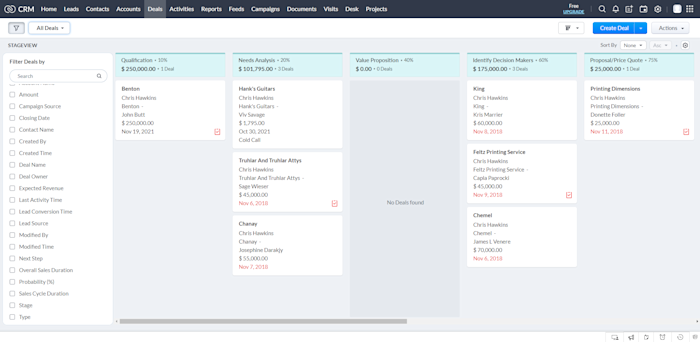
As your business grows, your technology needs usually change with it. And the company best equipped to handle this growth is Zoho. Starting with their free CRM, Zoho provides affordable, incremental upgrade paths, plus access to their other suite of business apps. There’s very little an organization would need—marketing, eCommerce, finance, HR—that Zoho doesn’t provide an app for.
The CRM includes deal management, tasks, and room for 5,000 records, which they define as contacts, accounts, deals, campaigns, and several other “modules.” The records used can be easily monitored and managed from Setup, then Data Administration and Storage, where recommendations are made for deleting untouched records. But note that you must upgrade to a paid plan to increase the modules limit.
Unfortunately, the free version now only integrates with one app: SalesIQ. This app provides live chat functionality and website visitor tracking by installing a code snippet in your website’s source code. It’s a nice tool to have in the box for sales, as it lets you answer initial visitor questions and ask qualifying questions. Then, if there’s enough interest, you can schedule a call from the chat. SalesIQ will score leads, track a chat visitor’s activity on your site, and send notifications when the contact revisits.
If you’re a solo operator, consider Zoho’s little CRM sibling, Bigin. It’s free for one user and can integrate with a handful of other Zoho products, Zoom, Gmail, and Zapier. If you need to upgrade from Bigin to any of Zoho CRM’s paid plans in the future to expand capabilities, it takes just a few clicks. See this comparison page to better understand Zoho’s and Bigin’s features and limitations.
By connecting Zoho or Bigin to Zapier, you’ll be able to add new contacts to your CRM whenever you have a new lead from an ad, a form, an order, or anywhere else, or get a notification whenever you have a new deal.
Zoho CRM Price: Free for 3 users; paid plans from $14/month/user
Best free CRM for businesses wanting lots of integration options
HubSpot CRM (Web, Mac, Windows, iOS, Android)
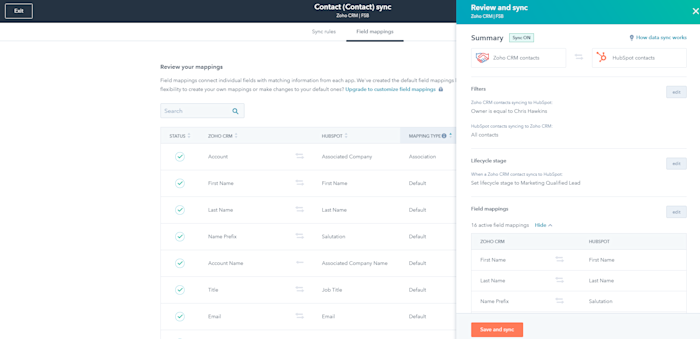
If you use multiple apps within your company and want a CRM to integrate with them, there’s no better choice than HubSpot CRM. The mammoth App Marketplace has over 900 integrations available to various levels of HubSpot plans (e.g., Marketing Hub) with CRM free users able to choose from over 800 apps in categories such as eCommerce, analytics, events, finance, project management, and customer success. Not only that, but many of these third-party apps provide free editions, which allows greater accessibility for small businesses with limited resources. And the new, included Operations Hub provides additional data sync features for a select group of apps.
The CRM is forever free and includes unlimited users and room for up to one million contacts. Included are deal tracking, landing pages, live chat/chatbot, basic email marketing, and a ticketing feature for tracking service requests. All of these are designed to provide a taste of their meatier Sales, Marketing, and Service Hubs, which provide advanced features at tiered pricing.
For many, the CRM will be all that’s needed to track deals and manage relationships, especially if you’re integrating with other business apps in your stack. For example, a good first step is to connect your Outlook 365 or Gmail account, so you can email directly from a contact record, track conversations, and use the sales templates to quickly respond.
HubSpot makes managing relationships easy with a contact record showing all sales, ticketing, and website activity with a timeline of pages viewed if the tracking code is installed. It will also show activity from your integrations. For instance, if you use Mailchimp for email campaigns, the contact record will show sends, opens, clicks, and bounces. Similarly, an Eventbrite integration will show an event registration in the contact’s timeline.
Connecting apps was straightforward for the handful I connected, but if you get stuck, each app’s integration page has a setup guide and resources to help. Also note that not all of the integration features will be available to free CRM users because they require features from the advanced paid plans.
HubSpot’s Operations Hub was released in April 2021 as a way to provide easier and cleaner data syncing between the CRM and third-party apps. Currently, there are over 50 apps available for this new syncing feature. As a test, I connected my Zoho free account from the list of “data sync built by HubSpot” apps in the Marketplace. With a few clicks, both apps were connected. Then I chose how my contacts were to sync using the rule option (there are dozens of filters) for only the contacts where I was the owner. The contact fields that are matched between the two apps defaulted to 16—to get custom field options, you need to upgrade to a paid plan. Finally, I clicked the review button for a summary of the sync and then clicked save and sync to start the process. Within about 20 seconds, all my contacts were shared bi-directionally between the two apps. So my HubSpot contacts synced with Zoho and vice versa. Any contacts I added or changes I made in either app immediately appeared in the other. Check out HubSpot’s Ultimate Guide to Operations Hub for more details.
Zapier creates thousands of additional integration options for HubSpot. For example, you can automatically add new leads or email marketing contacts to HubSpot as contacts. Learn about five of the most popular ways to automate business operations in HubSpot.
HubSpot CRM Price: Free for unlimited users with free features from the Operations Hub included automatically; from $45/month/Hub if you add on the Marketing, Sales, or Service Hub. Operations Hub and CMS Hub plans start at $60/month and $23/month, respectively.
Best free CRM software for managing projects
Insightly (Web, iOS, Android)
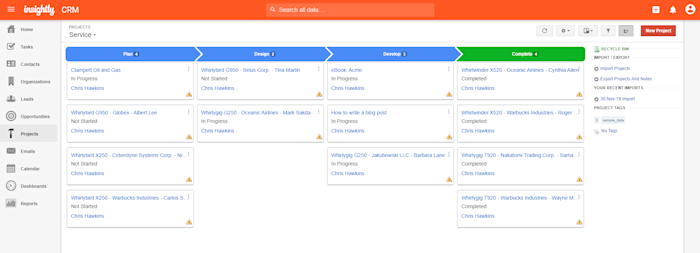
I’ve used Insightly in two different roles over the years: sales and project management. For both, the platform performed well, and I knew I was just chipping the surface of what it could do. And that’s true even with their free plan, which allows two users. So if you and a partner need to manage both relationships and projects, Insightly provides lots of potential to start and to grow.
To get a handle on how Insightly is organized, start with the items on the left-side navigation bar. These—contacts, leads, opportunities, emails, and others—are called objects and comprise the records you can create. A record lives in an object with fields to be filled out, such as name, phone, email, or any data you want to track. And you can create new fields, make them required, and customize the layout of fields on the page.
Once a record is created, you can perform actions for, say, a contact, such as changing them to a lead or adding a task, project, or activity set. An activity set is a group of automated tasks and events. For example, if you have a standard process for starting projects, you can create tasks for your colleague to email a new client within three days of closing the sale, another to set up a first meeting in five days, and so on. Activity sets can also be triggered during the different stages of a project.
If you provide services, you can create pipelines and the accompanying stages to manage each one as a separate project and link it to a company, contact(s), and other projects. All of these relationships show up in the various records, so you always have a complete picture of what’s going on. So if I’m talking to a client about another project, I can easily see the progress of their other outstanding projects.
One feature of Insightly that’s not found in a lot of CRMs, especially free plans, is the ability to track your leads using a Kanban board. Similar to creating opportunities and project pipelines, you can create all the steps in your qualification process (e.g., “first call attempt,” “contacted,” and “disqualified”), and move them along the board by dragging and dropping into the next status. Leads can be created from any screen with the quick add button, from contacts, and by importing them.
Something to keep in mind is the 2,500-record limit with the free plan (records include contacts, leads, orgs, projects, tasks, emails, notes, reports, and comments). If you have a lot of moving pieces for sales and projects, this can add up quickly. You can check your records usage in the billing and account section under your profile image.
To get the most out of Insightly, you can connect it to Zapier, which can automatically add or update records based on form submissions, calendar events, or other triggers in your favorite apps.
Insightly Price: Free for 2 users; paid plan from $29/user/month
Best free CRM software for ease of use
Capsule (Web, iOS, Android)

Most CRMs do more than just managing contacts and deals, adding major functions such as marketing and helpdesk to their platforms. So far, Capsule has mostly resisted this trend, which is nice if you want to keep relationship management straightforward.
Using Capsule is a breath of fresh air if you’ve ever worked in anything more involved than an email inbox. The user interface is uncomplicated and, in fact, provides little in the way of customization—you can change the color scheme and add a logo, but that’s it. Six small icons on the left provide access to the main features with account settings on the far right. On every screen is a dropdown to add people, organizations, opportunities, and cases. This means lots of white space in between.
Capsule provides customization options for the fields for people, organizations, and opportunities, which is handy to tailor data capture to your business. In several minutes, I created a decision-maker checkbox field and a dropdown menu for customer types such as vendor, supplier, VAR, and end-user for people and opportunities.
Another nice feature is called Tracks. This lets you create a repeatable set of activity reminders for opportunities. For example, a standard process for a new inbound lead might have five steps for follow-up, spread over two weeks, using a combination of emails and calls. Tracks applied to these leads automatically populate the opportunity record as a list of to-dos to be checked off.
If you’re a Gmail or Outlook user, be sure to download Capsule’s email add-on. This lets you add contacts, opportunities, and tasks right from your inbox with a few clicks. It will also automatically save (unless you disable) all ongoing email threads into that contact’s record. Missing, however, is the ability to send emails directly from a contact’s record. This is a feature available in all of the other free CRMs reviewed here.
Finally, if you’re coming into Capsule with hundreds of contacts, you’ll either need to do some scrubbing (usually a good idea) or look elsewhere because the free plan only allows 250. Upgrading to the first paid tier ($18/mo/user) bumps the contact limit to 50,000.
Zapier opens up more opportunities to use Capsule with other apps, such as posting won opportunities in Slack and creating new sales opportunities in Capsule when they’re entered in a spreadsheet.
Capsule Price: Free for 2 users; paid plans from $18/month/user
Best free CRM with inexpensive upgrade options
Vtiger (Web, iOS, Android)
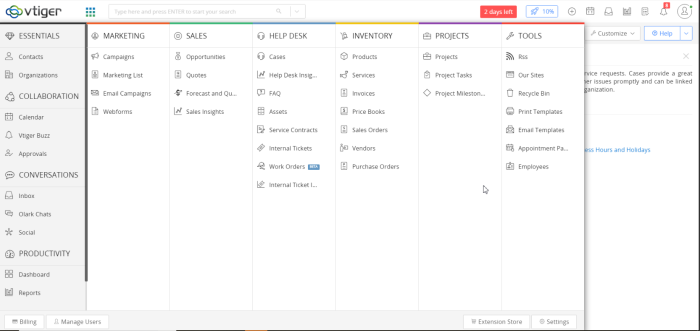
As a free CRM, Vtiger is loaded with features many small businesses will find appealing: contact/deal management, support ticketing, email marketing, and a nice selection of reporting options, to name a few. It includes room for 10 users and up to 3,000 records. When you add the inexpensive upgrade paths—sales starting at $10/user or all-in-one starting at $30/user—Vtiger becomes a real bargain. Let’s take a look at some of the highlights of the free version and what you can expect when you upgrade.
The navigation is a little different from other CRMs. To access any of the app’s main functions, which Vtiger calls Modules, click on the hamburger at the top left. This displays a menu of all your apps with favorites at the top and the apps such as sales, marketing, and help desk underneath on the left side. If you hover over an app, all of its functions will display to the right for access. For example, for sales, you’ll see deals, email sequences, leaderboard, and others. Just click and go. It took me a bit to get used to it, but once I did, it made getting anywhere in the app speedy.
For contact records, you can calculate a Profile Score, which helps determine if a person falls within your ideal buyer profile. Under settings, you can assign numerical values for title, lead source, size of company, revenue, and industry. As long as these values are picked when creating a contact and company (e.g., using the title CEO gets 10 points), you’ll get a rating based on five stars appearing prominently at the top of a record. It gives your team some idea whether a contact is a good potential fit—but not how engaged they are like traditional lead scoring. In Vtiger’s paid plans, there’s another scoring system called Engagement Score, which tracks a contact’s engagement level with your email campaigns.
With the marketing module, you can build custom landing pages to capture contacts, segment those contacts into lists, and then send one-time emails. You get 1,000 email credits (one email = one credit) a month and can purchase additional send credits (e.g., 50,000 emails is $100) as needed.
I created a test campaign, and it was pretty smooth. You create your send list; set conditions for the list such as lead source, last contacted date, idle leads, and dozens more; and create your email using the email campaigns feature (which offers dozens of templates). Once you’re done, preview the email for desktop and mobile and then send yourself a test email before sending it to your list. Each campaign provides data for opens, clicks, bounces, and other metrics. Upgrading to paid plans provides significantly more email credits, campaign scheduling, and autoresponder campaigns that send emails based on triggers.
To get more out of Vtiger, connect it with Zapier to do things like sending Facebook leads automatically to Vtiger or creating Vtiger leads whenever someone’s added to your email list.
Vtiger Price: Free for 10 users. Paid plans start at $10/month/user.
Best free CRM for Gmail users
Streak (Gmail, iOS, Android)

Streak is one of the few free CRMs we could find that lives in your Gmail inbox, which means no separate app to log in to. If you’re a one-person operation wanting to manage contacts and deals from your inbox, Streak is worth a test drive.
Once you download their extension, you’ll see the orange icon in the top right corner of your inbox. Clicking on that will bring up your settings, help, integrations, and other options. One thing to note is that you can’t share your pipelines with others with the free plan (upgrade to the $49/month plan required), so this is ideally suited for one person.
Though it’s part of your Gmail, it does take a little getting used to because it doesn’t behave like other CRMs that have their own apps. It has a more Excel look and feel. That said, once you understand it, it’s nice to have one place to manage contacts, deals, and even projects. Contacts can be added from emails to leads and pipelines with a few clicks. Once added, all subsequent emails with that contact will be color-labeled as a lead and/or deal, and all details (tasks, notes, activity, etc.) appear in a right-hand column. To open up the contact’s full record, click on their email address in the column sidebar. Here you can see your full email history with the contact and add tasks, notes, and other activities.
To create a pipeline, click on the Pipelines plus sign directly under your Drafts folder. A Templates screen pops up, allowing you to pick a number of sales, support, HR, and other project-type pipelines, which can be customized with stages, stage colors, and fields (e.g., source, industry, priority).
One handy feature is email tracking. When a recipient opens your email, a pop-up will appear on your screen notifying you. Streak will then display the tracking history with that contact in the sidebar for any email thread, showing email views by date and location. A green eye icon indicates the email has been read, while an eye with a line through it indicates it hasn’t.
If you upgrade to a paid plan, you can integrate Streak with Zapier, which allows you to do things like create boxes in Streak from new spreadsheet rows or captured leads.
Streak Price: Free for 2 users; paid plans from $15/month for 1 user
Originally published in December 2014, this post is regularly updated with new selections and descriptions. Matthew Guay contributed to previous versions.
[adsanity_group align=’alignnone’ num_ads=1 num_columns=1 group_ids=’15192′]
Need Any Technology Assistance? Call Pursho @ 0731-6725516

